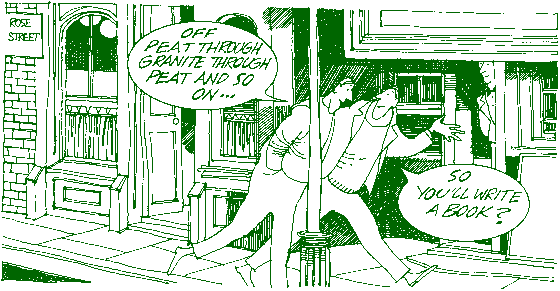

In November 1944 I found myself back in Edinburghon leave for a week. I went into Thin's book shop, where I hadbrowsed so often as a student in the early 1930's, and picked upa copy of Neil Gunn's Whisky and Scotland (firstpublished in 1935) for the sum of five shillings (25p). This bookchanged my life.
Gunn's book is a lively history of Scotch whiskywith a passionate plea for single malts. It presented a vividpicture of the different malts with their distinctive qualities,and made me realise the variety and individuality of the productsof the distilleries. From then on I searched out single maltwhiskies, determined to sample and savour as many as I could.
In wartime Britain any kind of Scotch whisky wasin very short supply, and it was some time after the end of thewar before normal supplies became available. Single malts werehard to find. I think it was in 1946, when I was again back inEdinburgh, that I found in Muirhead's of George Street (retailwine and spirit merchant, long since disappeared, owned I believeby Macdonald and Muir, who had the Glenmorangie distillery) abottle of Glenmorangie, a whisky I had never tasted before. Itwas then that I started my whisky scrapbook, in which I pastedthe labels of each bottle of malt that I bought, with a note ofits characteristics.
I think I was the first to trumpet the virtues ofGlenmorangie. When some years later I became a Fellow of JesusCollege, Cambridge, I persuaded the college to buy Glenmorangieby the case from Muirhead's and it became a favourite of theFellows. Other colleges in Cambridge heard of this and soonGlenmorangie became well known among the academics. I rememberwhen Hugh MacDiarmid visited Cambridge to give a lecture there,he was delighted (having suffered from a surfeit of sherry) tofind that I had a bottle of this whisky in my college rooms,where together we consumed a large quantity.
My involvement with Glenmorangie developedfurther when my son married a girl from Tain (where thedistillery is) and on several visits to my son's parents-in-law Igot to know the distillery well.
Meanwhile I was searching for other malts andsampling and writing up in my scrapbook as many as I could find.I would come across the odd bottle of a great prewar malt tuckedaway on the top shelf of a wine-merchant or licensed grocer,forgotten and unappreciated until I liberated it.
The next step on my whisky trail was when thepublisher André Deutsch, who had published several of my books,visiting Edinburgh at Festival time in the mid 1960s, asked me tointroduce him to real Scotch whiskies. So I took him a pub-crawlalong Rose Street, and we drank single malts in pub after pub,beginning with Eastern malts at the Abbotsford and movingwestwards we moved along the pubs in the street, ending withIslays at Ma Scott's. With each whisky I explained itscharacteristics, pointing out that here the water had come offpeat through granite and there it had come off granite throughpeat. You taste the difference? I asked. (All this was pureinvention on my part.) He nodded sagely.
This resulted in André asking me to write a bookfor him on Scotch whisky. By a happy coincidence I had arranged aterm off from the University of Sussex where I was then teaching,and so was able to spend a wonderful October going round Scotlandvisiting distilleries, savouring different malts and talking tomanagers, maltmen, brewers and stillmen. It was a great and happyeducation, supplemented by my reading in Scotland's social andeconomic history. And so my book was written, and my education inmalt whisky has been progressing ever since.
Professor David Daiches is a long-timesupporter of the Society and a former member of the TastingPanel.
If you have comments about thissite, please contact the